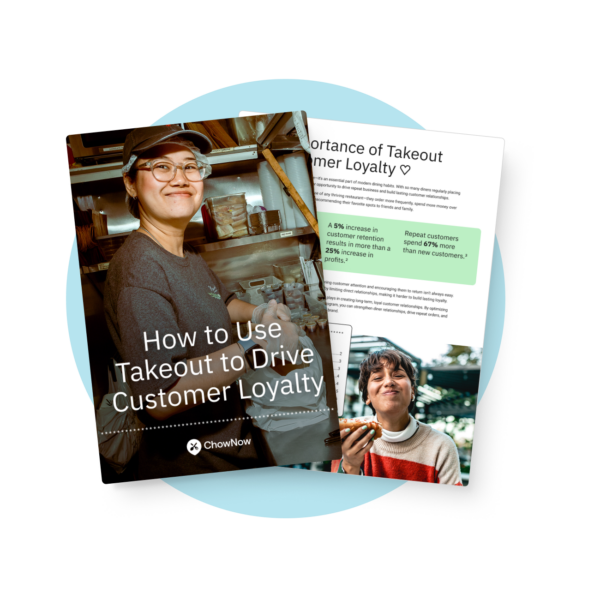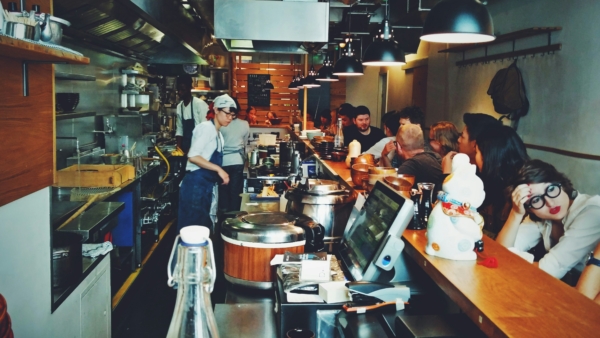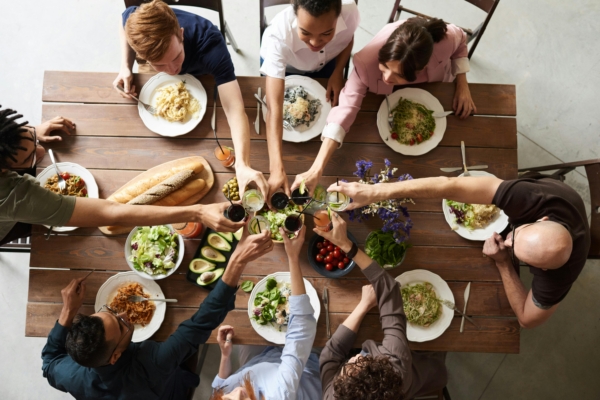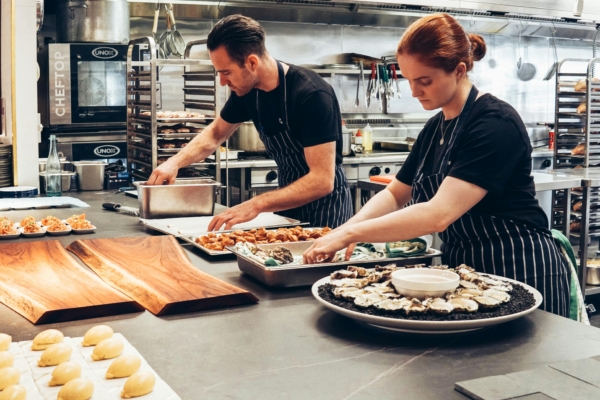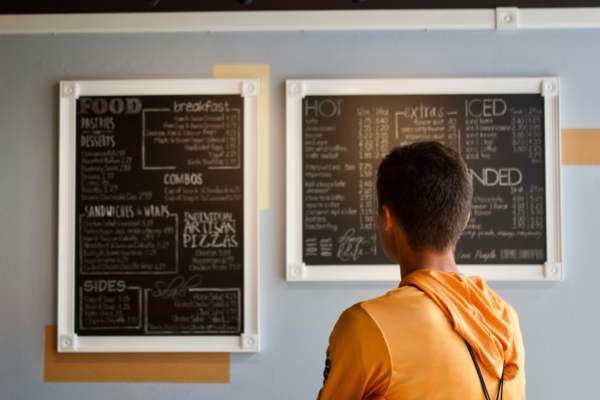Restaurant Menu Engineering Techniques to Maximize Profit

You can have a crowd-pleasing menu, loyal regulars, and a packed dining room—and still watch your margins disappear.
Why?
Because not every dish that’s popular is profitable.
Too many restaurant menus are built on intuition and aesthetics, not real numbers.
If you’re making decisions based on gut instinct or what “feels right,” you’re guaranteed to be leaving money on the table.
If you want to escape the guesswork and increase your monthly profits, you need to use menu engineering—it blends psychology, data, and clever design to help you sell more of your most profitable items.
In this article, you’ll learn:
- How to use menu analysis to find out what’s making (or costing) you money
- What to do with low-margin fan favorites, and how to turn hidden gems into stars
- Smart, subtle menu engineering tricks to boost sales without raising menu prices
Let’s get started by taking a closer look at what menu engineering is and why you should use it in your restaurant.
What Is Menu Engineering and Why Should You Care?
Menu engineering is the process of using data and design to make your menu more profitable.
It blends sales data, food cost, and menu psychology to help you stop guessing and start making decisions that grow your margins.
The goal isn’t just to sell more—it’s to sell more of the right things.
A restaurant menu built with menu engineering helps you guide guests toward more profitable items without them even realizing it.
It’s subtle, strategic, and rooted in numbers.
One of the biggest misconceptions about menu engineering is that it’s just about menu design, meaning fonts, colors, and layout tricks.
Sure, those details matter (and we’ll get into them), but that’s a surface-level view.
Real menu engineering efforts are grounded in hard numbers: data, food cost percentage, and how much profit each dish actually brings in, so you know exactly what to promote, rework, or cut.
When you understand this, you stop designing a menu that “looks good” and start building one that works.
How to Analyze Menu Performance: Popularity vs. Profitability
Before you can make your menu more profitable, you need to understand how your menu items are performing.
That means going beyond what sells well and digging into what dishes are actually making you money.
Start by gathering two key data points for each menu item:
- Item’s Popularity: How often guests order it
- Contribution Margin: How much profit it brings in
To do this, you’ll need to access your sales data and your food cost for each dish.
If you’re using a modern POS system or inventory management software, you likely already have most of this information easily at your disposal.
Once you’ve got your numbers, you can map every dish onto what’s called the menu engineering matrix—a tool that will help visualize a menu item’s popularity or profitability.
Every item on your menu will fall into one of these four categories:
- Stars: High profitability, high popularity. These are your MVP all-stars. Promote them, protect them, and never mess with them without a good reason.
- Plowhorses: Low profitability, high popularity. Guests love them, but they don’t pull their weight financially. These are candidates for portion adjustments or pricing tweaks.
- Puzzles: High profitability, low popularity. Hidden gems with potential. These need better placement, new names, or stronger staff recommendations.
- Dogs: Low profitability, low popularity. Unless there’s a good reason to keep them (like being a house specialty or a key part of your concept), they’re probably taking up valuable real estate on your menu.
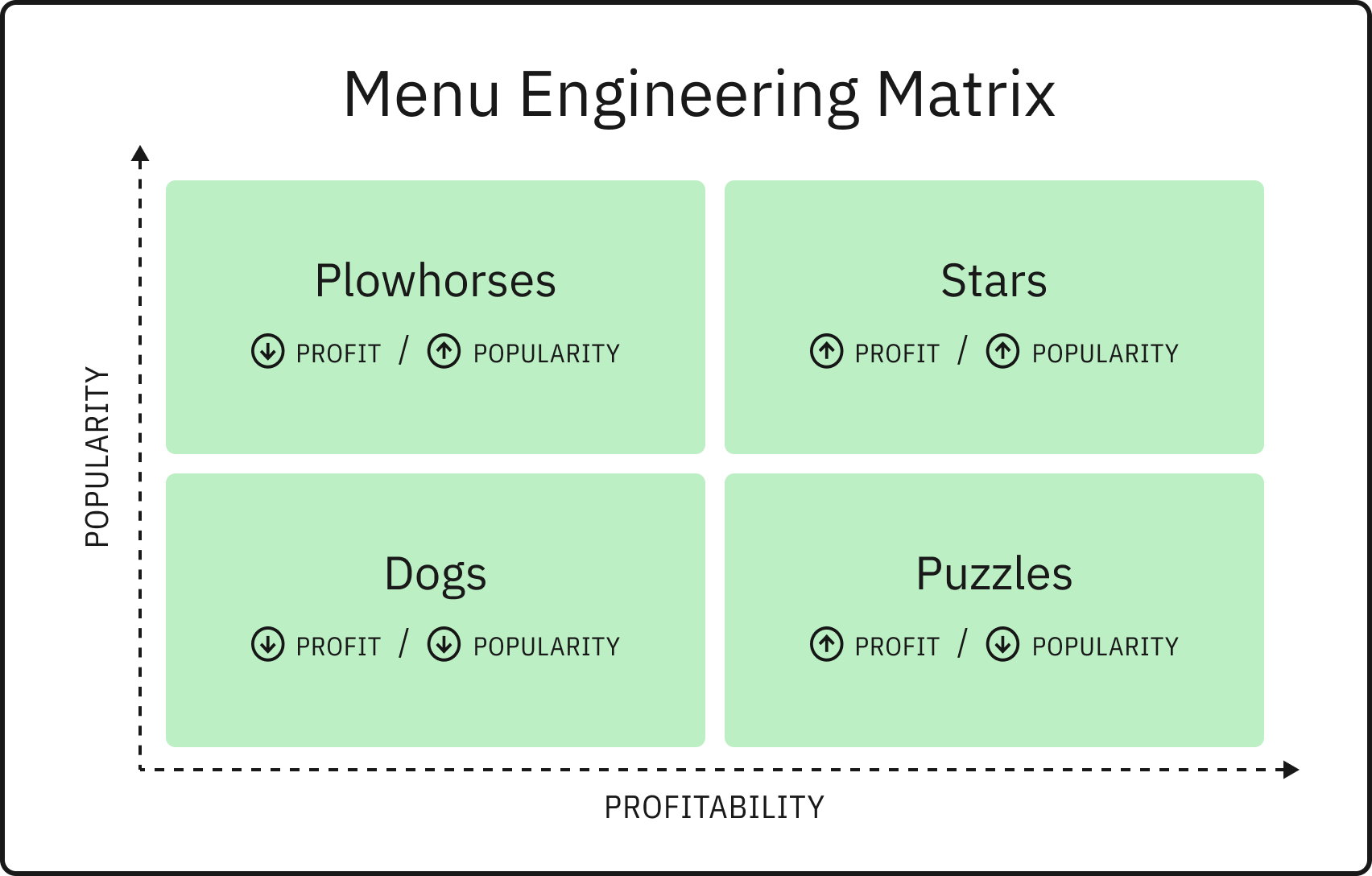
This kind of menu analysis isn’t something you do once; it’s an ongoing part of the menu engineering process.
As time goes on and you’ve mapped your entire menu, patterns will emerge. You’ll start seeing which dishes are carrying the team and which ones are quietly draining your bottom line.
The more often you review your menu performance, the easier it becomes to spot trends, test ideas, and keep your restaurant profits moving in the right direction.
Strategies to Improve Profit Through Menu Engineering
Once you’ve categorized where each dish lands in the menu engineering matrix, you can start making strategic changes to increase your restaurant profits without overhauling your entire operations.
Here’s how to approach each type of item strategically.
Highlight Your Stars
Your popular and profitable dishes are your foundation. You want them front and center—top of a menu section, in a callout box, and suggested by your servers.
Make sure the menu description sells the dish; lean into sensory words and house-made touches: “chargrilled,” “signature,” or “slow-roasted.”
These are the items that should lead your marketing, your online menu, and your limited-time offers.
Optimize Your Plowhorses
These are your crowd favorites, but don’t bring in much profit. To make them more valuable, try adjusting portion size, swapping in lower-cost ingredients, or pairing them with high-margin upsells as an add-on.
Promote Your Puzzles
Puzzles have strong contribution margins, but nobody is ordering them. This is often a menu psychology problem.
Try renaming them with a more enticing menu description, giving them better placement in your menu layout, or training your staff to recommend them more consistently.
Phase Out or Rework Dogs
If a dish has low sales and low profitability, it might be time to cut your losses.
In some cases, a slight menu price adjustment or repositioning might help, but often, it’s better to retire them early before they cost you more money or swap them out for new dishes with better potential.
Outside the matrix, you should lean into menu psychology—subtle design, wording, and pricing techniques that naturally guide guests toward dishes you want them to pick without ever feeling pressured.
Use tactics like:
- Price anchoring—placing a high-priced item next to your target to make it feel like a better deal
- Removing dollar signs to reduce price sensitivity
- Write stronger menu descriptions to tap into customer preferences
These menu engineering tricks may seem small, but every change will nudge guests toward more profitable menu choices.
Menu Layout Tips That Influence What Customers Order
Now that you’ve categorized and optimized your menu items, it’s time to take those menu psychology techniques a step further and apply them to your menu layout.
How you organize your menu matters more than most people realize.
Smart design choices shape what guests notice first, what they linger on, and what they ultimately order.
Here are a few proven techniques to keep in mind when shaping your menu layout.
Understand the Golden Triangle
When customers open a physical menu or an online menu, their eyes naturally move in a triangle: first to the center, then to the top right, and then to the top left.
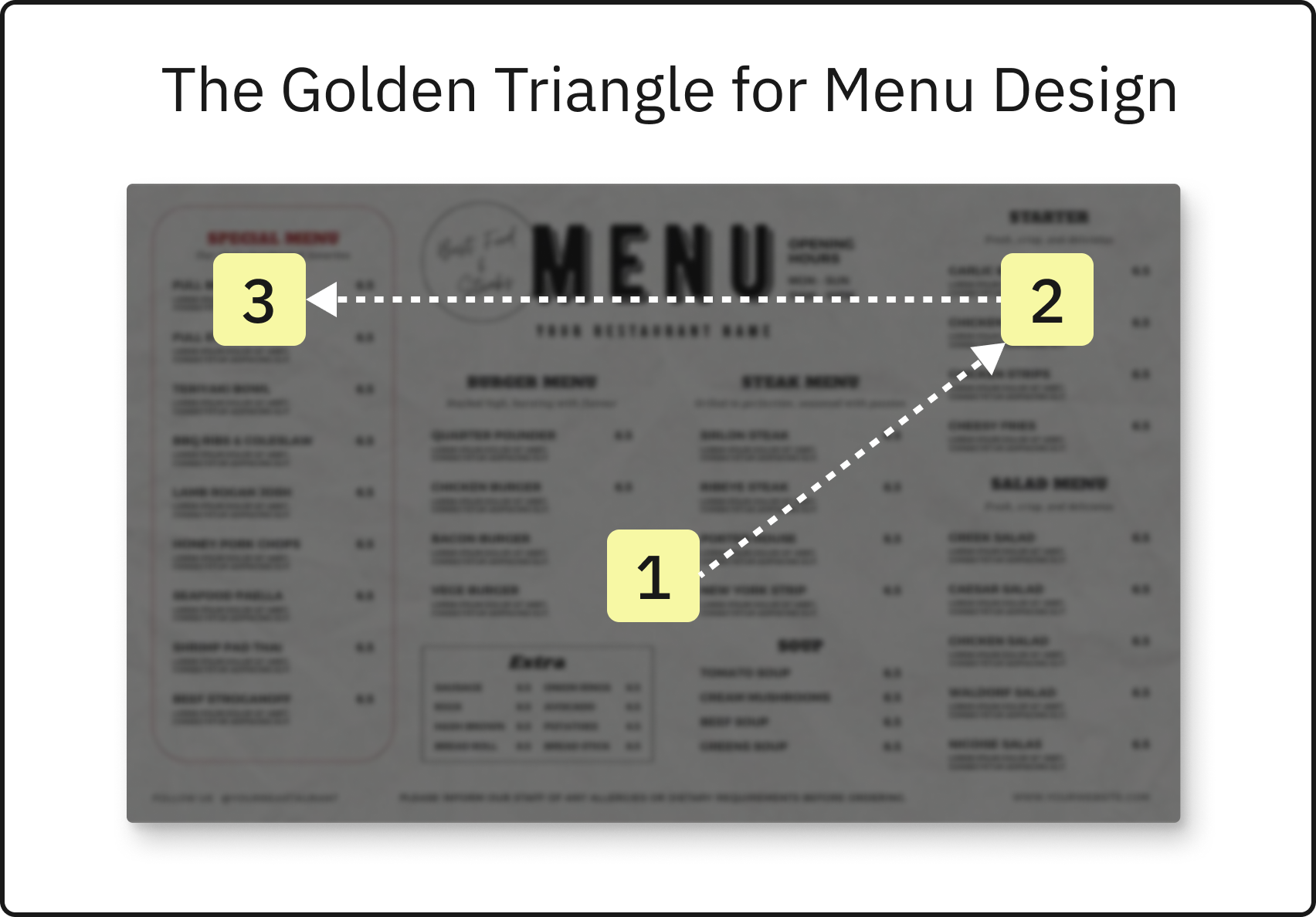
These are your high-visibility zones.
Put your profitable items—especially your Stars from the menu matrix—in these prime spots to catch attention right away.
If your best-sellers and high-margin dishes aren’t placed in these hot spots, you’re missing a huge opportunity to drive higher check averages.
Limit Menu Options
Too many choices can overwhelm customers and lead to what’s called decision fatigue, which can hurt sales volume.
That’s when they default to safe, familiar dishes, often the ones with the lowest gross profit margin.
Many restaurants have succeeded by cutting down their menu offerings to guide diners more clearly.
A smaller, tighter menu makes it easier for guests to choose confidently and often pushes them towards the dishes you want to sell most.
Use Visual Cues
Boxes, bold fonts, icons, and strategic spacing can draw the eye to specific menu sections or dishes you’d like to sell more, but don’t overdo it—if everything is emphasized, nothing stands out.
Small pricing tweaks work the same way. A study from Cornell University found that customers spent about 8% more when menus removed dollar signs compared to menus that included them.
These little shifts might seem minor on their own, but layered together across your entire menu, they show exactly how menu engineering works.
It’s not about making one massive change—it’s about stacking smart, subtle moves that steadily boost your gross profit margin.
How to Maintain and Evolve Your Menu Over Time
Building a profitable restaurant menu isn’t a set-it-and-forget-it project—it’s an ongoing process.
Guests’ tastes shift.
Ingredient costs fluctuate.
Your kitchen team’s strengths evolve.
That’s why regular updates are a crucial part of smart menu engineering efforts.
Review Your Sales and Cost Data Regularly
The first step is committing to regular menu analysis. Every few months, pull your sales data and review your food cost numbers.
Are your Stars still as popular as ever?
Have any of your Plowhorses dropped further into low-profit territory?
Keeping a close eye on your menu performance means you’ll spot problems early, before they drag down your margins.
Test Seasonal and Limited-Time Items
Running limited-time offers or seasonal specials is a smart way to keep your menu fresh without fully committing to new recipes.
It’s also a low-risk way to try out new concepts, gauge customer preferences, and find what works to fill gaps in your current menu offering.
Listen to Your Staff and Your Guests
Getting feedback from staff and customers rounds out the picture of your menu’s successes and failures.
Servers know which dishes they’re confidently recommending and which ones guests hesitate over.
Diners’ comments, even casual ones, give you clues about customer preferences and what holes you might need to fill with new dishes.
Encourage regular input from staff and keep an eye on social media comments and review sites like Google and Yelp to spot patterns, then make adjustments when necessary.
Stay Consistent, but Flexible
Consistency builds trust with your customers, meaning you shouldn’t overhaul your entire menu every month.
We’ve said it several times in this article, but the most effective way to execute menu engineering is to focus on making small, strategic updates based on real numbers and feedback.
This approach helps reduce food waste, improves inventory management, and ensures your menu engineering efforts stay sustainable long-term.
A profitable menu isn’t built overnight. But with the right systems in place, it becomes a living, breathing part of how you maximize restaurant profits—month after month, year after year.
Keep Evolving Your Menu and Watch Your Profits Grow
You can expect to see results after just one round of menu engineering, but that doesn’t mean you’re done. Keep leaning into the practice, and use the techniques from this article to spark your creativity, enhance your guests’ experience, and grow your profits over time.
Contact ChowNow to learn how you can get your own branded Restaurant Website to display your online menu and increase your online orders.
